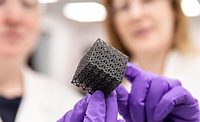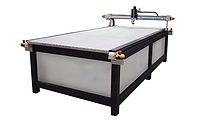
The joining together of large structures such as wind turbine blades or ship hulls strictly with adhesives (vs. mechanical fastening techniques) has become a common practice. The current challenge is how to bring the adhesive bonding process into a mainstream operation that increases production throughput while maintaining control and minimizing manufacturing costs.
Many factors need to be addressed when scaling up the bonding process, not the least of which is the question of how to reliably dispense thousands of pounds of adhesive each day, with minimal waste. Advancements in novel pumping technology for paste adhesives are successfully addressing the challenges of large-scale industrialization by quickly and reliably meter-mixing significant volumes of reactive two-component adhesives. The reactive mix is then directly dispensed to bond lines hundreds of meters long or manually pumped into buckets for manual application.

Direct dispensing along a bond line using a whip hose and forming applicator.
Properties of Paste Adhesives
Paste adhesives are usually non-slumping fluids (thixotropic pastes) that are supplied as separate A and B components in 200-liter drums. Mix ratios are anywhere between 1:1 and 3:1 by volume for epoxies or urethanes, and as wide as 100:2 for catalyzed polyesters. All types may include variable or selectable hardeners for faster or slower curing times to counteract ambient plant temperature changes.Care must be taken to prevent fluctuations in ambient plant temperatures that are lower than 20°C or over 35°C. If temperatures are too cold, the flow rates and cured properties are negatively affected; if too high, the adhesive mix might become runny and cure too fast to assemble the components. The rule of thumb is that work life is affected by a factor of two for every 10°C change in temperature. For example, an adhesive work life of two hours at 25°C will be cut down to only one hour at 35°C.
Another rule of thumb involves material flow rates: Viscosity is inversely related to material temperature. The viscosity drops rapidly as the temperature increases. Depending on the materials, a 10°C increase can lower the viscosity by 50%. Many other issues come into play with these rules, so they should be used only as rough guidelines.
Six important areas should be considered when qualifying a viable high-flow adhesive dispense process and machine for paste adhesives.

Figure 1. Homogeneous Mix Evaluation
Mix Ratio
Material suppliers report physical cured properties of their adhesives at their specified ratio of resin to hardener, such as 1:1 or 100:50 pbv (parts by volume). They may also specify a ratio tolerance of ± X%, within which suitable physical attributes of cured adhesive can be achieved. Most meter/mix machines specify the delivery of a mix ratio to within ± 1-2% of a set point, which is often well within the range of an adhesive supplier’s recommended ratio.When considering the application of a “wet” adhesive to large-scale composite parts, verification of ratio becomes an important aspect of the entire adhesive application process. To aid ratio verification, many adhesives are supplied with part “A” being a different color than part “B,” so a correct blended color can be quickly observed when the parts are mixed at the proper ratio. Ratio variances large enough to result in a blended color change observable to the naked eye indicate an obvious “event” that can usually be diagnosed and corrected, such as an empty container, damaged delivery hose or partially cured mixing tube.
Precision inline flow meters, one for Part A and one for Part B, are used if more precise verification is needed (e.g., 1-2% accuracy). The Graco VPM (Variable Paste Machine) employs inline flow meters for each component and a process of calibration using weight sampling. Electrical pulses from these two flow meters are processed in the onboard computer and provide both real-time process information and data streams that can be saved as a historical record of the dispensing process. The end result is a robust adhesive delivery process that provides a high degree of certainty that the proper ratio is delivered to the substrate.

Close up of platen during changing of a drum.
A/B Mix Quality
Once proportioned, the individual components are delivered into a high-flow inline mixer. While dynamic mixers are used in some cases to blend difficult-to-mix chemistries, the majority of dispense machines use static mixing to take advantage of their low maintenance. The Graco VPM uses a 1-1.5 in. diameter static mixing tube with 24 interior mixing elements that divide the material back and forth to accomplish blending. Since the individual A and B components are different colors, a good mix emerges as a homogeneous color with no striations or lead-lag concentrations.Figure 1 shows a test sample being evaluated by spreading a bead of dispensed material to check for color uniformity throughout. During the qualification testing of a new adhesive, the material supplier can perform more quantitative tests on a cured sample, such as glass transition, one-hour water boil test, thermo mechanical analysis (TMA), etc.
The key design criteria for an inline mixer include a tube diameter that is sized to the flow rate and viscosity, and the number of dividing elements inside the mixing tube. The more dividing elements, the more mixing occurs. A good starting point is 24 elements that will divide the streams by 224, or over 16,000,000 times.

Figure 2. Blue stripes indicate adhesive use in blade bonding. (Image courtesy of Henkel Corp.)
Flow Rate
High flow rate is important in large-scale bonding processes for two reasons. First, the work life of the mix is short (less than one hour, in many cases). Hundreds of pounds of adhesive need to be dispensed, and the faster the adhesive can be laid down, the more time is left for assembly.Second, production capacity and cost are critical. Molds are expensive, space is at a premium, and capacity is strained due to the market demand of wind energy turbines and other large composite structures. The faster a blade can be turned around, the more capacity a given plant can provide.
A typical 2.5 MW wind blade is 50 m in length and can use up to 600 kg (1,300 lbs) of mixed adhesive for all its various bonded areas (see Figure 2). If the working life of a mixed adhesive is one hour and assembly time is 30 minutes, less than 30 minutes is left for the dispensing of what may be 1,000 pounds of adhesive.
In one test, the Graco VPM dispensed a 3:1 ratio paste adhesive at 75°F and achieved a flow rate of 330 gms/s (43.5 lbs/m). At 85°F, the flow rate increased to 400 gms/s (52.8 lbs/m), which illustrates the importance of ambient temperatures on flow rate. (These rates are for illustration purposes and may vary depending on many factors.)
It is also important to factor in the effect of the A:B ratio. As the ratio increases (e.g., 2:1 vs. 3:1), more part A material is required to meet the flow rate. The part A (resin) material is typically the higher viscosity component. This results in greater flow rate of the higher viscosity material. Thus, the A material pump must work harder to obtain the flow rate and usually is the limiting factor to increasing the flow rate.

Example of a 1,200-liter bulk supply container.
Bulk Supply
Once the dispensing process starts, a 200-liter drum of resin can be emptied in as little as 15 minutes. The requirement for replacing an empty drum with a full one is a frequent occurrence during a large-scale bonding process. The Graco VPM features semi-automated controls to enable an operator to quickly change out a drum, minimizing the impact on the entire bonding process. Taking time out of the dispensing process to change out a drum is yet another reason to design high-flow-rate machines. To eliminate the change-out time, a tandem drum set can be used for each component. When one drum becomes empty, the new full drum automatically takes over.A third alternative to bulk supply is the 1,200-liter drum. The unit shown at left is used for polyester adhesives that are mixed in a 100:2 ratio, thus putting virtually the entire flow rate demand on the base component. By using a 1,200-liter container, a large volume of adhesive can be supplied to the bonding process without interruption.

VPM metering system in a mobile configuration.
Mobility
Designed for mobility, the Graco VPM allows better positioning along the blade structure as the bonding process continues. In a manual troweling process, as many as 20 people may be going to the dispenser to fill up a bucket of premixed adhesive. The ability to follow along the work area is an important criterion to speed production and reduce operator fatigue.In more automated processes, the VPM dispenser can be pulled along the work piece and, with the use of a whip hose and forming head, a formed bead can be directly applied to the bond line, thus eliminating buckets and reducing labor.

Figure 3. Sample Production Display
Ease of Use and Maintenance
The final consideration for an automated meter/mix machine is its ease of use and maintenance. Figure 3 is a sample of a graphic user interface that provides a production snapshot of all the relevant parameters during the bonding operation. Displays include intuitive procedures that assist in the startup, operation, shut-down and maintenance of the dispensing unit. Key to this technology is the ability to transfer historical data surrounding every bonding process so a record is available for every pound of material dispensed onto a structure.Increasing Industrialization
The manufacture of adhesive-bonded composite structures is rapidly evolving into an industrialization phase. Manufacturing speed and reliability are essential to the continued adoption of composites technology in large-scale markets. The Graco VPM adhesive machine is a cost-effective and reliable tool for processing considerable volumes of the paste adhesives required for bonding large-scale composite structures.For more information, contact Graco at 8400 Port Jackson Ave. NW, North Canton, OH 44720; phone (800) 746-1334; fax (330) 966-3006; email ohiocs@graco.com; or visit www.graco.com/sae.


